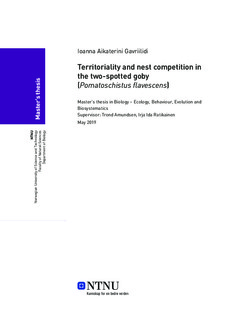| dc.description.abstract | Intra-sexual competition plays an important role in the evolutionary process of sexual
selection. Male-male competition over resources that are essential for mating success may
prevent unsuccessful competitors from breeding. The intensity of competition is influenced
by the availability, quality, and distribution of such resources. The spatial distribution of
resources may facilitate monopolisation, limit the density of breeders and skew the
reproductive success among individuals in a population. In some species, one such resource
is favourable nests sites, which males compete for, occupy and defend against intruders. The
aim of this study was to test the extent to which nest spacing, and specifically inter-nest
distance, induces intra-sexual competition (territorial aggression). In order to address this
question I focused on how distance between pairs of nests affects nest occupancy, mating
success and asynchrony in breeding of male two-spotted gobies (Pomatoschistus flavescens),
a small fish with a resource defence based breeding system and uniparental care provided by
males. Results show that shorter inter-nest distance did not affect nest occupancy, mating
success or asynchrony in breeding of males and does not appear to intensify male-male
competition. These results suggest that nest spacing does not limit the density of breeding
males. However, further studies are required to understand the effect of nest spacing on the
intensity of sexual selection. The high occupancy rates, irrespective of distance, suggest that
the artificial nests are favourable nesting sites. Although potential natural nesting sites for the
two-spotted gobies seem to be abundant in the studied area, high-quality nests might be in
limited supply. | |
